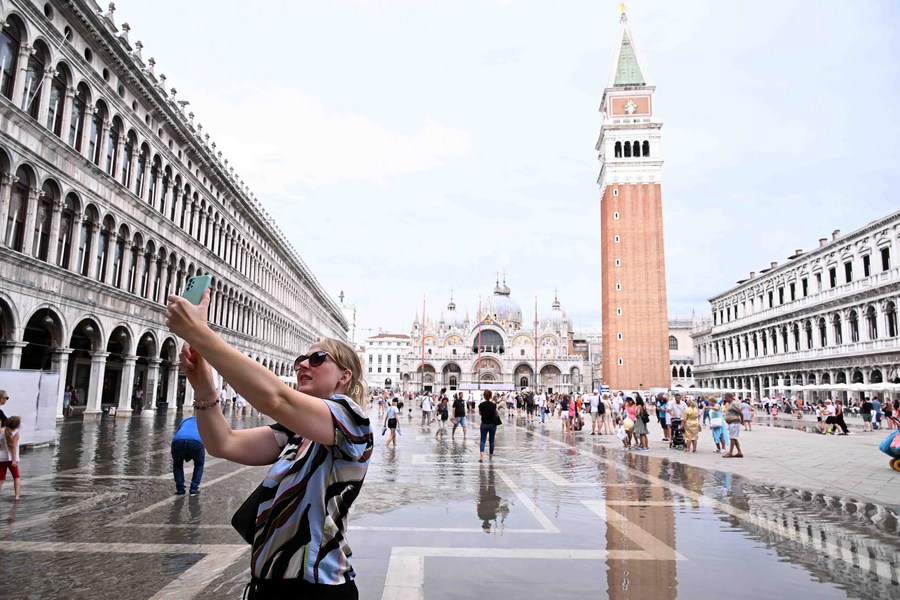发布日期:2024-07-20 04:52 点击次数:122


A tourist takes a selfie at the waterlogged St. Mark's Square in Venice, Italy, Aug. 4, 2023. (Photo by Alberto Lingria/Xinhua)
In an effort to curb the increase in the number of acts of cultural vandalism, Italy in April passed a law that would allow vandals who damage monuments to be fined up to 60,000 euros (65,500 U.S. dollars). According to Italy's Minister of Culture Gennaro Sangiuliano, the new measure is aimed in part at dissuading those considering vandalism and in part at offsetting the cost of undoing the damage they have done.
ROME, Aug. 21 (Xinhua) -- Over the course of its long and storied history, Italy has been ransacked, seen the collapse of empires and kingdoms, and survived national disasters. Today, the country is enduring a wave of misbehaving tourists.
Italy's tourism sector has all but recovered from the COVID-19 pandemic's impact. However, a small percentage of the much sought-after visitors have recently been caught mistreating and vandalizing the country's cultural riches.
四房色播Earlier this month, a 19-year-old French tourist was detained by the police after she carved her initials into Tuscany's famed Leaning Tower of Pisa. Also this summer, three young people were separately caught carving their names into the walls of Rome's iconic Colosseum. A month ago, the capital city's Aurelian Walls, dating from the 3rd century A.D., were defaced.
In one of the most high-profile cases of abuse, a Saudi man was arrested last year for damaging Rome's picturesque Spanish Steps by driving his rented sports car down them. In 2016, vandals damaged the marble Elephant and Obelisk statue by Renaissance sculptor Gian Lorenzo Bernini, breaking off part of the elephant's tusk.
This is not a new phenomenon. Virtually any ancient monument in Italy bears evidence of the country's past: anything from words or names carved into walls to entire chunks of buildings removed to be used as materials for assembling newer buildings.
Tourists visit the Arena di Verona in Verona, Italy, on Aug. 2, 2023. Verona is located in north Italy's Veneto. (Xinhua/Jin Mamengni)
"Historical and cultural sites are valued differently today than they were in the past," Anthony Majanlahti, a historian of Rome, told Xinhua. "In that context, these abuses we're seeing are clearly vandalism and that shouldn't happen. Time already takes its toll on these things, and we cannot allow that to be hastened along by human actions."
Cecilie Hollberg, director of the Accademia Gallery in Florence, said she thought the problems were a function of the large and growing number of visitors frequenting the most popular sites for tourists and a lack of awareness from some of the people visiting.
"Look at a small city like Florence, which is built to be home to 300,000 or 350,000 people and it gets 14 million visitors in a year," Hollberg told Xinhua. "That means there are 14 million possibilities of someone doing some kind of damage."
Hollberg said there is also a problem that people are ignorant of the fragility and value of some of the monuments and sites they are damaging. To wit: one of the tourists caught carving his name in Rome's Colosseum claimed he was unaware that the famed structure -- which is nearly 2,000 years old -- was as ancient as it is.
In an effort to curb the increase in the number of acts of cultural vandalism, Italy in April passed a law that would allow vandals who damage monuments to be fined up to 60,000 euros (65,500 U.S. dollars). According to Italy's Minister of Culture Gennaro Sangiuliano, the new measure is aimed in part at dissuading those considering vandalism and in part at offsetting the cost of undoing the damage they have done.
The measure was passed after a series of incidents that saw environmental activists harming cultural sites -- such as dying the water in Rome's Baroque-style Barcaccia Fountain black -- to call attention to their cause.
"Whoever carries out these acts must assume financial responsibility," Sangiuliano said.
Other preventive measures are in effect as well, such as the installation of security cameras and increasing the number of guards patrolling important sites.
Hollberg said she had another idea that could serve the same purpose as the tougher fines.
This photo taken with a fisheye lens shows people waiting for the Palio in Siena, Italy, July 2, 2023. (Photo by Alberto Lingria/Xinhua)
"People have to clean up what the vandals have done at the taxpayers' expense," she said. "It's sensible to punish these transgressions. But maybe you could also have the transgressors do the cleaning themselves张筱雨人体艺术, with a very small toothbrush. Maybe that would make them think twice." ■